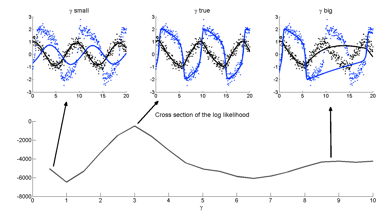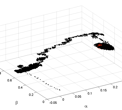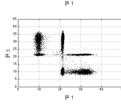Research ----- Prospective Students ----- Current Team ----- My Education----- Open Data Set Acquisition and Cleaning
Research




Differential Equation Models
Differential Equation (DE) models are theoretically built mechanistic models for complex systems. A single nonlinear (DE) model can describe a wide variety of behaviours including oscillations, steady states and exponential growth and decay, with few but readily interpretable parameters. Consequently, DE models are routinely used in describing chemical reaction dynamics, predator-prey interactions, heat transfer, economic growth, epidemiological outbreaks, climate and weather prediction, gene regulatory pathways, turbulence,... The wide range of complex dynamics that a single model can produce complicates all areas of estimation and motivates most of my research and has led me to work on Uncertainty Quantification, Parameter Estimation, Computational Bayesian Methods, and Poorly Identified Models. I’ve also done some work on Time-Frequency Methods.
Uncertainty Quantification
Differential Equation models typically require numerical methods to solve for their implicitly defined states. In complex models, especially those involving chaotic or stiff dynamics, small errors introduced by the numerical solver accumulate leading to exponential divergence from the true system solution. As such classic numerical error tolerance bounds are inadequate to describe the functional uncertainty in the produced solution. I’m interested in how to define probability measures on the function space of possible differential equation solutions and how these functional distributions can be incorporated into the inference problem.
- McDonald, S., Campbell, D. (2025) "A probabilistic diagnostic for Laplace approximations: Introduction and experimentation” The Canadian Journal of Statistics
- Shaun McDonald, Alexandre Leblanc, Saman Muthukumarana & David Campbell (2025) "FRODO: a novel approach to micro–macro multilevel regression” Computational Statistics
- McDonald, S., Campbell, D. (2021) "A Review of Uncertainty Quantification for Density Estimation” Statistics Surveys (open access)
- Chkrebtii, O., and Campbell, D. (2019) “ Adaptive step-size selection for state-space based probabilistic differential equation solvers” Statistics and Computing
- Chkrebtii, O. , Campbell, D., Girolami, M. and Calderhead, B. (2015), “Bayesian Uncertainty Quantification for Differential Equations” Bayesian Analysis, with discussion
- Golchi, S., Bingham, D., Chipman, H., Campbell, D. (2015) Monotone Function Estimation for Computer Experiments, Journal of Uncertainty Quantification
Parameter Estimation for Differential Equation Models
I'm most interested in DEs without an analytic solution. Unfortunately the flexibility of this class of model implies that a likelihood centred on the solution to the DE is full of local maxima, ridges, ripples, flat sections and other difficult topologies. These give rise to a host of statistical challenges that I have been researching from Bayesian and frequentist perspectives. Here's a talk I gave in Banff giving an overview on statistical methods for differential equation models
- Campbell, D. and Chkrebtii, O. (2013), “Maximum profile likelihood estimation of differential equation parameters through model based smoothing state estimatesMathematical Biosciences, doi:10.1016/j.mbs.2013.03.011
- Campbell, D., Hooker, G., McAuley, K. (2012), "Parameter estimation in differential equation models with constrained states" Journal of Chemometrics
- Ramsay, J. O., Hooker, G., Campbell, D., and Cao, J. (2007), "Parameter estimation for differential equations: a generalized smoothing approach (with discussion)Journal of the Royal Statistical Society Series B, 69, 741-796.
Computational Bayesian Methods
I am working on Bayesian sampling methods aimed at overcoming the unique challenges of dynamic system models. Often posterior densities for differential equation models have multiple modes and deep posterior valleys, sometimes thousands of units deep on the log scale. I am working on methods that can bypass these prohibitive topologies and produce a reasonable sample from the target posterior.
Dynamic system models often have more parameters than the data can uniquely determine and this lack of identifiability may arise in several ways. Parameters may be mathematically non-identifiable meaning that the model is such that even with continuously error-free data some parameters can not be uniquely determined. Parameters may be practically non-identifiable meaning that when observed at discrete time points with noise and possibly with some missing states some parameters may not be estimable with a 'reasonably' or even finite small confidence region. Finally parameters may be statistically non-identifiable meaning that the data set that you happen to have observed is not adequate to estimate parameters uniquely. I am working on methods to enable parameter estimation of estimable parameters that can automatically deal with and determine subsets of parameters that can not be uniquely estimated. My interest in time-frequency analysis grew from my research into Wavelets and Fourier analysis. I am interested in adaptive estimation of the instantaneous frequency of a signal and the issues in time-frequency methods in the presence of errors in recording of time.
Research ----- Prospective Students ----- Current Team ----- My Education----- Open Data Set Acquisition and Cleaning
Poorly Identified Models
Time-Frequency Analysis and State Space Models
Environmental Toxicology
Statistical Work in Forensic Science, Nursing, Psychology